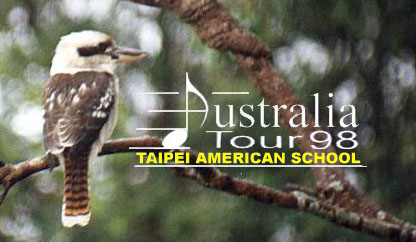

 I
went on this trip to Australia over spring break with our High School Orchestra
and Opus. Even though this was not strictly a birding trip, I was told
that there will nevertheless be lots of birds to see. Apparently, they
were right, that many species of colorful birds were easily seen without
too much effort. Initially, I had hoped to see at least one hundred species
(a group that just came back from Australia told me they saw more than
two hundred species), but the itinerary did not provide enough time nor
the right locations to find one hundred species in such a short time. Nevertheless,
out of the 74 species of birds I saw during this trip, 57 were life birds
for me (77%). Not quite close enough to a hundred, but not too disappointing
either. The Australian birds that I haven't seen on this trip will be the
ones awaiting my discovery on my next trip to Australia sometime in the
future.
I
went on this trip to Australia over spring break with our High School Orchestra
and Opus. Even though this was not strictly a birding trip, I was told
that there will nevertheless be lots of birds to see. Apparently, they
were right, that many species of colorful birds were easily seen without
too much effort. Initially, I had hoped to see at least one hundred species
(a group that just came back from Australia told me they saw more than
two hundred species), but the itinerary did not provide enough time nor
the right locations to find one hundred species in such a short time. Nevertheless,
out of the 74 species of birds I saw during this trip, 57 were life birds
for me (77%). Not quite close enough to a hundred, but not too disappointing
either. The Australian birds that I haven't seen on this trip will be the
ones awaiting my discovery on my next trip to Australia sometime in the
future.
April 4, Saturday
We arrived at Sydney Airport around 7 AM and the weather was sunny. Anxious to see new birds, I looked around for signs of bird life. The first bird I saw was a SILVER GULL cruising over the parking lot. Soon, I saw many more all over the place. In a distance was a flock of WELCOME SWALLOWS in the sky. Hopping among the parked cars were HOUSE SPARROWS and a COMMON STARLING. Leaving the airport, I saw a WHITE-FACED HERON in flight and a MAGPIE-LARK on a curbside. On the highway on the way to the Blue Mountains, I saw many birds out the window, but the only ones I could see clearly enough to identify were a LAUGHING KOOKABURRA on a wire, ROCK DOVES (feral pigeons), three AUSTRALIAN RAVENS, two COMMON MYNAS, and four SULPHUR-CRESTED COCKATOOS. A light tan raptor was perched on the wires of the rail cars running parallel to the road, but I was not able to identify it.
At 11:00, we reached the entrance of the scenic railway at Blue Mountains.
Near the picnic tables were flocks of PIED CURRAWONGS and a couple AUSTRALIAN
MAGPIES. 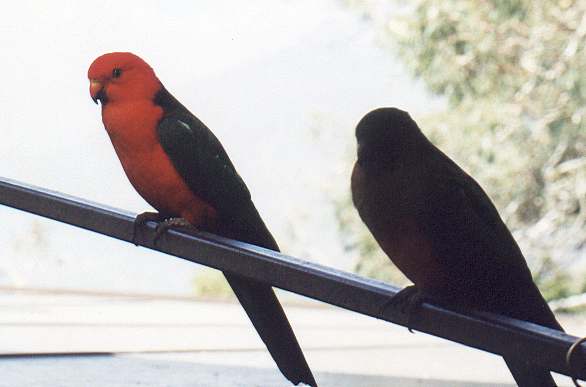 These
birds were extremely fearless and would perch within a meter when offered
food. On a flowering tree were some LEWIN'S HONEYEATERS. At the boarding
platform was a feeding dish with a pair of GANG-GANG COCKATOOS, about six
AUSTRALIAN KING PARROTS, and a CRIMSON ROSELLA feeding around it. These
birds appeared so tame that at first I could not believe that they were
wild! After the thrilling ride down the steepest railway in the world,
I took the trail towards the right through the wet forest. Birds were calling
from every direction, but they were extremely difficult to spot. I managed
to see a GREY FANTAIL, two YELLOW-THROATED SCRUBWRENS, three EASTERN SPINETAILS,
and an active flock of STRIATED THORNBILLS.
These
birds were extremely fearless and would perch within a meter when offered
food. On a flowering tree were some LEWIN'S HONEYEATERS. At the boarding
platform was a feeding dish with a pair of GANG-GANG COCKATOOS, about six
AUSTRALIAN KING PARROTS, and a CRIMSON ROSELLA feeding around it. These
birds appeared so tame that at first I could not believe that they were
wild! After the thrilling ride down the steepest railway in the world,
I took the trail towards the right through the wet forest. Birds were calling
from every direction, but they were extremely difficult to spot. I managed
to see a GREY FANTAIL, two YELLOW-THROATED SCRUBWRENS, three EASTERN SPINETAILS,
and an active flock of STRIATED THORNBILLS.
We then stopped at Echo Point in the afternoon. In the dry forest, I saw a WHITE-EARED HONEYEATER, a male AUSTRALIAN KING PARROT, a female SCARLET ROBIN, and more GREY FANTILS.
After watching The Edge on the gigantic screen of the Maxivision Theater, the whole afternoon was spent traveling to Grose Vale Conference Centre, where we would spend the night. In the last hour of daylight, from 5 to 6 PM, I wandered around looking for birds around the area, especially for what the manager said where "bellbirds." There was a flock of about nine CRIMSON ROSELLAS feeding in a tree outside our room. On a nearby meadow with cattle, there were two AUSTRALIAN MAGPIES on the grass and five CATTLE EGRETS with a WHITE-FACED HERON accompanying the cattle. A DARTER flew overhead, making me wonder whether there was a source of water nearby. As I entered the forest, whose underbrush looked like it had been burned, I heard the calls of the "bellbirds," which were actually Bell Miners, but I could not see any no matter how hard I tried! I saw dozens of NOISY MINERS, two GALAH (cockatoos), and a lone LAUGHING KOOKABURRA as darkness fell.
After dinner, I walked on the same road through the forest again searching for owls and frogmouths. I heard what I suspect to be a Boobook (at least it sounded like "boo-book," but then again, I could probably have tricked myself into thinking that any two-syllable call was a Boobook!). Anyhow, I gave up after a couple hours of search with no luck.
April 5, Sunday
I woke up at five to continue the search for nocturnal birds. Even though I heard some funny vocalizations before sunrise at 5:30, I did not see anything. At daybreak, the laugh of the LAUGHING KOOKABURRA began echoing everywhere. I then saw NOISY MINERS feeding in a flowering tree. I walked through the forest for the third time on the same road and heard the Bell Miners again at the exact same location, but I still could not find any. I saw that the most abundant birds around were NOISY MINERS. I also saw a WILLIE WAGTAIL, a male ROSE ROBIN, two LEWIN'S HONEYEATERS, and large flocks of a small bird that were probably STRIATED THORNBILLS again. A small, dull bird that I now think was a Mistletoebird was pecking at fruits at the top of a tree, but I could not positively identify it even though I had long, clear looks of it. I also met a kangaroo as it bounded through the trees. On the grassy fields outside the forest, I saw three WILLIE WAGTAILS, an AUSTRALIAN RAVEN, two CRESTED PIGEONS, an AUSTRALIAN HOBBY, four MAGPIE-LARKS, about five AUSTRALIAN MAGPIES, two COMMON STARLINGS, a COMMON MYNA, and a GALAH. Returning to the centre, I was greeted by a pair of AUSTRALIAN KING PARROTS as they flew directly over my head.
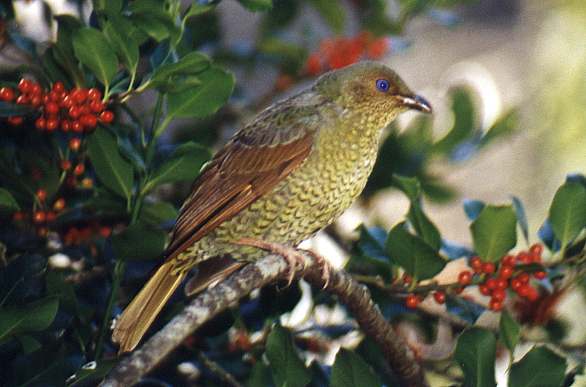 We
then headed to Jenolan Caves after breakfast for a guided tour through
the impressive limestone caves. On the bus ride to the caves, I looked
out the window and saw lots of birds, but most were impossible to identify.
I saw two LAUGHING KOOKABURRAS, an AUSTRALIAN RAVEN, lots of NOISY MINERS,
a white cockatoo, and a raptor that barely resembled an Australian Hobby
perched on a wire. At Jenolan Caves, I first saw a female SATIN BOWERBIRD
feeding on the berries of a tree over the picnic area. As we entered the
caves, I saw three female MALLARDS swimming in the lake below. After the
guided tour, we ate lunch at the picnic area. PIED CURRAWONGS, AUSTRALIAN
MAGPIES, and a couple female SATIN BOWERBIRDS scavenged for scraps around
the tables. During the free hour we had after lunch, I walked around the
wildlife reserve but only saw a female AUSTRALIAN KING PARROT and a flock
of RED-BROWED FINCHES (FIRETAIL), plus a couple unidentified species.
We
then headed to Jenolan Caves after breakfast for a guided tour through
the impressive limestone caves. On the bus ride to the caves, I looked
out the window and saw lots of birds, but most were impossible to identify.
I saw two LAUGHING KOOKABURRAS, an AUSTRALIAN RAVEN, lots of NOISY MINERS,
a white cockatoo, and a raptor that barely resembled an Australian Hobby
perched on a wire. At Jenolan Caves, I first saw a female SATIN BOWERBIRD
feeding on the berries of a tree over the picnic area. As we entered the
caves, I saw three female MALLARDS swimming in the lake below. After the
guided tour, we ate lunch at the picnic area. PIED CURRAWONGS, AUSTRALIAN
MAGPIES, and a couple female SATIN BOWERBIRDS scavenged for scraps around
the tables. During the free hour we had after lunch, I walked around the
wildlife reserve but only saw a female AUSTRALIAN KING PARROT and a flock
of RED-BROWED FINCHES (FIRETAIL), plus a couple unidentified species.
Leaving Jenolan Caves, I saw out the window three black cockatoos in flight, the most likely possibility being YELLOW-TAILED BLACK-COCKATOOS, as we passed through the pine forest. The bus driver (coach captain) pointed out to me a LAUGHING KOOKABURRA sitting on a sign before I fell asleep.
We arrived at Collaroy Center, where we will spend rest of our nights, at dusk. As I got off the bus, I was met by huge flocks of RAINBOW LORIKEETS and MUSK LORIKEETS with their piercing chirps in the trees directly overhead! It was too dark, however, to see their brilliant colors. That night, I did a short search for birds but was not able to hear nor find anything.
April 6, Monday
I was woken up by a sudden burst of parrot shrieks and screams at 6 AM. I grabbed my binoculars and ran outside. There were hundreds of RAINBOW and MUSK LORIKEETS feeding on the flowering trees outside. Everywhere I went I could not escape from their loud screeches. In the midst of my excitement, I dropped my binoculars by accident. A disaster, as they would not able to focus well for the rest of the trip. Luckily, I could still use them to identify species.
We performed a concert for Beacon Hill High School in the morning. On the field of the campus were lots of AUSTRALIAN RAVENS, about two dozen WELCOME SWALLOWS, two COMMON MYNAS, and AUSTRALIAN MAGPIES. On the driveway of a house nearby were two CRESTED PIGEONS.
We then went to Waratah Park to have lunch and feed kangaroos and Emus. On the way, I saw what looked like a MASKED LAPWING walking causally across the road. I could not help but wonder, "Why did the Lapwing cross the road?" as Northern Lapwings never do this in Taiwan! Soon, I saw another MASKED LAPWING on the lawn. In the park, we had fun teasing the talking cockatoos and feeding the kangaroos, Emus, Manned Ducks and Mallards (I think these ducks were also captive). Other birds wandering in the park were Indian Peafowls, Helmeted Guinea Fowls, and a Yellow-tailed Black Cockatoo. Feeding in the cage of a tree kangaroo was a large flock of RED-BROWED FINCHES (FIRETAIL) and some Bar-shouldered Doves, although I could not see how the doves could have entered the cage, so they probably were not wild birds. The only actual "wild" birds were dozens of AUSTRALIAN RAVENS, a male SCARLET ROBIN, and a GREY SHRIKE-THRUSH. I also saw an interesting "Australian native birds" postcard at the gift shop (Warning: some people may find this type of humor offensive; open at your own risk!).
As we left the park, I saw two LAUGHING KOOKABURRAS in a tree by the road and another MASKED LAPWING in a field. We also passed a large pond that had some black birds and some white birds floating in it; the white birds looked like pelicans, but I did not see any of them clearly enough to identify.
 After
we returned to Collaroy Center to spend the rest of the afternoon, I could
see that there were lots of white birds over the ocean, but they were too
far away to identify, though most were probably Silver Gulls anyway. There
was also a raptor over the ocean that was probably a BLACK-SHOULDERED KITE.
It disappeared from view as it plunged into the water to catch prey. There
were still lots of RAINBOW LORIKEETS and NOISY MINERS in the trees, and
three GALAH fed on the lawn as WELCOME SWALLOWS flew only a couple feet
from the ground.
After
we returned to Collaroy Center to spend the rest of the afternoon, I could
see that there were lots of white birds over the ocean, but they were too
far away to identify, though most were probably Silver Gulls anyway. There
was also a raptor over the ocean that was probably a BLACK-SHOULDERED KITE.
It disappeared from view as it plunged into the water to catch prey. There
were still lots of RAINBOW LORIKEETS and NOISY MINERS in the trees, and
three GALAH fed on the lawn as WELCOME SWALLOWS flew only a couple feet
from the ground.
That evening, we watched the musical Les Miserables at the Theatre Royal, so I did not have time to search for birds.
April 7, Tuesday
I was again woken up by the screeching of LORIKEETS, both RAINBOW and MUSK. There was nothing new, only more NOISY MINERS, AUSTRALIAN MAGPIES, and three LAUGHING KOOKABURRAS sitting in a tall tree outside.
Our morning was spent on a tour of Sydney, so I did not expect to see many birds. The most abundant were AUSTRALIAN RAVENS, SILVER GULLS, and ROCK DOVES (feral pigeons). When we passed through various parts of the city by bus, I also saw three GALAH, a WELCOME SWALLOW, COMMON MYNAS, and a MASKED LAPWING. During our stop at The Gap, at a cliff overlooking the ocean, there was trawler followed by a large flock of gulls and other seabirds. They were mostly SILVER GULLS, but I also saw a CRESTED TERN and couple chocolate-brown shearwaters, probably WEDGE-TAILED SHEARWATERS. A raptor also hovered in a distance, and its body coloring suggested a BLACK-SHOULDERED KITE. Too bad I did not have a spotting scope for a more detailed look at these birds.
After a tour of the Opera House, we went on a cruse of Sydney Harbour (Darling Harbor) in the afternoon. SILVER GULLS were extremely abundant, and I also saw a CRESTED TERN. There were some white-bellied cormorants on the shore which I had difficulty identifying because of the distance. There were also some black-bellied cormorants on some of the street lamps. One had a white face, so was most likely a GREAT CORMORANT; the others looked like LITTLE BLACK CORMORANTS. As we returned to the dock, I saw three cormorants perched at the base of a flagpole: a PIED, a LITTLE PIED, and a LITTLE BLACK. With this wonderful opportunity for comparison among the three, I was finally able to see and identify these birds clearly.
April 8, Wednesday
As usual, I was woken by birds in the morning and found three LAUGHING
KOOKABURRAS in the same tree outside. I decided to take a walk by the beach,
hoping for something new. SILVER GULLS were ubiquitous, and I saw three
AUSTRALIAN PELICANS in the surf and a WILLIE WAGTAIL on the beach. Seeing
nothing special, I walked towards the golf courses by the Long Reef Aquatic
Reserve. Two STRIATED HERONS (gray morph) and a flock of white egrets flew
overhead. On the grass of the golf course were flocks of COMMON STARLINGS,
AUSTRALIAN RAVENS, 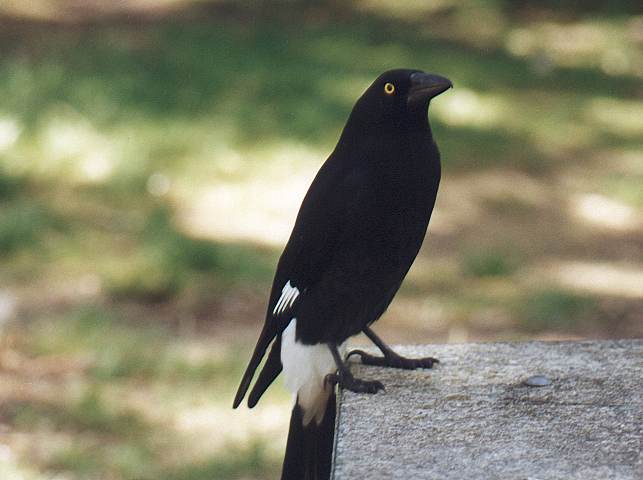 PIED
CURRAWONGS, AUSTRALIAN MAGPIES, and two MASKED LAPWINGS. A BLACK-SHOULDERED
KITE hovered over the field for a while before moving on. There were also
SPOTTED TURTLE-DOVES on the fences and wires. A trail led to the edge of
the cliff through a grove of flowering trees. Two black cormorants were
feeding in the ocean, probably LITTLE BLACK CORMORANTS. Feeding on the
nectar of the flowers were flocks of RAINBOW LORIKEETS, a flock of NEW
HOLLAND HONEYEATERS, even larger flocks of YELLOW-FACED HONEYEATERS, a
few EASTERN SPINEBILLS, and a small flock of WHITE-BROWED SCRUBWRENS. A
flock of unusual looking RED WATTLEBIRDS and BRUSH WATTLEBIRDS was also
feeding among the flowers of the trees. As I walked back, a NANKEEN (AUSTRALIAN)
KESTREL perched on an antenna by the roadside. WELCOME SWALLOWS were flying
around, and the three AUSTRALIAN PELICANS had landed on the beach to rest.
Too bad I did not bring my camera this morning or I could have taken lots
of pictures of these birds! A GREAT and a PIED CORMORANT flew across the
sky, and I saw more COMMON STARLINGS, SPOTTED TURTLE-DOVES, NOISY MINERS,
COMMON MYNAS, and a SULPHUR-CRESTED COCKATOO as I returned.
PIED
CURRAWONGS, AUSTRALIAN MAGPIES, and two MASKED LAPWINGS. A BLACK-SHOULDERED
KITE hovered over the field for a while before moving on. There were also
SPOTTED TURTLE-DOVES on the fences and wires. A trail led to the edge of
the cliff through a grove of flowering trees. Two black cormorants were
feeding in the ocean, probably LITTLE BLACK CORMORANTS. Feeding on the
nectar of the flowers were flocks of RAINBOW LORIKEETS, a flock of NEW
HOLLAND HONEYEATERS, even larger flocks of YELLOW-FACED HONEYEATERS, a
few EASTERN SPINEBILLS, and a small flock of WHITE-BROWED SCRUBWRENS. A
flock of unusual looking RED WATTLEBIRDS and BRUSH WATTLEBIRDS was also
feeding among the flowers of the trees. As I walked back, a NANKEEN (AUSTRALIAN)
KESTREL perched on an antenna by the roadside. WELCOME SWALLOWS were flying
around, and the three AUSTRALIAN PELICANS had landed on the beach to rest.
Too bad I did not bring my camera this morning or I could have taken lots
of pictures of these birds! A GREAT and a PIED CORMORANT flew across the
sky, and I saw more COMMON STARLINGS, SPOTTED TURTLE-DOVES, NOISY MINERS,
COMMON MYNAS, and a SULPHUR-CRESTED COCKATOO as I returned.
After breakfast, our morning was spent rehearsing for a concert at Carlingford High School. As we were walking towards the school auditorium, I saw two rosellas, a green and a red, which I thought were different species until I looked at the field guide. They were both CRIMSON ROSELLAS; the red was an adult and the green was an immature.
In the afternoon, we each went home with a student of the school. My host family lived by a reserve, and the student took me on a trail through the wildlife sanctuary. Not many birds were active in the afternoon, but around the neighborhood were SPOTTED TURTLE-DOVES, NOISY MINERS, COMMON MYNAS, RAINBOW LORIKEETS, AUSTRALIAN MAGPIES, and some EASTERN SPINEBILLS. Birds were harder to spot through the trees in the reserve, but I found a new species, the SILVEREYE, and also saw what looked like owl shit on the ground, though no owl was in the tall tree directly above. I also saw a couple nice swallowtail butterflies in the reserve, including some Common Bluebottles and an Orchard Swallowtail.
After an enjoyable afternoon and a pleasant dinner with the host family, I returned to the school for the concert that evening.
April 9, Thursday
It finally rained for the first time on our trip, though the shower did not last very long. Nevertheless, the whole day was cool and cloudy. We visited the Glendswood Colonial Farm to sheer sheep and throw boomerangs. While we tossed boomerangs, three CRESTED PIGEONS saw quietly on a nearby fence looking at us and an AUSTRALIAN PELICAN soared overhead. I then looked at a small pond in the golf course nearby and saw two MASKED LAPWINGS by the water (where I thought they looked more appropriate!), a pair of CHESTNUT TEALS, and a LITTLE PIED CORMORANT drying its wings.
After lunch (a feast with a huge piece of steak!), we had some free
time and I went to explore some other nearby ponds. I passed an overgrown
patch of grass and more than thirty RED-RUMPTED PARROTS exploded out and
landed in a tall tree. Everywhere on the ground, rooftops, fences, stood
COMMON MYNAS. Also on the ground were COMMON STARLINGS, SPOTTED TURTLE-DOVES,
NOISY MINERS, 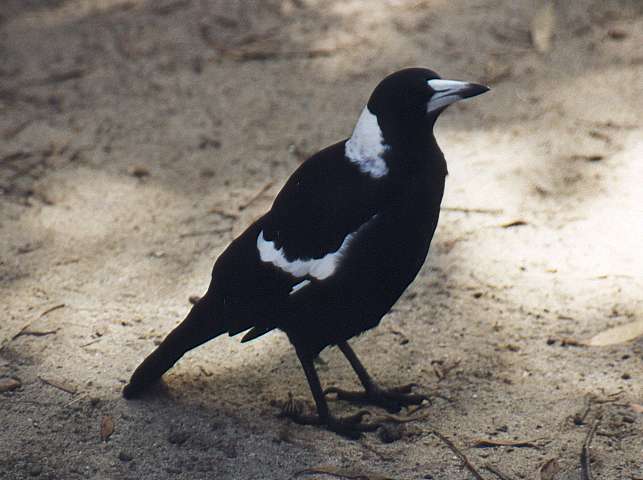 AUSTRALIAN
MAGPIES, MAGPIE-LARKS, and HOUSE SPARROWS. When I reached the ponds, I
first noticed the EURASIAN COOTS and GREY TEALS. Then a PURPLE SWAMPHEN
emerged from the grass and an AUSTRALASIAN GREBE in breeding plumage with
three juveniles popped out of the water. A bird's nest, probably belonging
to the grebes, was built in the middle of the pond. WILLIE WAGTAILS were
running along the side of the pond and WELCOME SWALLOWS also flew low over
the water. After seeing everything in the first pond, I went to the adjacent
pond, scaring off two MASKED LAPWINGS. In the adjacent pond, there was
an even larger flock of GREY TEALS mixed with CHESTNUT TEALS, one a breeding
male, and PACIFIC BLACK DUCKS. DUSKY MOORHENS chased each other in the
water, two more PURPLE SWAMPHENS emerged, and a male AUSTRALASIAN SHOVELER
stood on the bank in the middle of a flock of GREY TEALS (there may have
been a pair of the shovelers). A LAUGHING KOOKABURRA, being harassed by
NOISY MINERS, landed on a dead tree, followed by a WHITE-FACED HERON. Suddenly
there was a huge commotion beneath that tree, and only then did I notice
the two AUSTRALIAN WHITE IBISES (SACRED IBIS) through the trees. I was
so absorbed by so many unexpected new finds that I lost track of time and
unintentionally held our group up for fifteen minutes.
AUSTRALIAN
MAGPIES, MAGPIE-LARKS, and HOUSE SPARROWS. When I reached the ponds, I
first noticed the EURASIAN COOTS and GREY TEALS. Then a PURPLE SWAMPHEN
emerged from the grass and an AUSTRALASIAN GREBE in breeding plumage with
three juveniles popped out of the water. A bird's nest, probably belonging
to the grebes, was built in the middle of the pond. WILLIE WAGTAILS were
running along the side of the pond and WELCOME SWALLOWS also flew low over
the water. After seeing everything in the first pond, I went to the adjacent
pond, scaring off two MASKED LAPWINGS. In the adjacent pond, there was
an even larger flock of GREY TEALS mixed with CHESTNUT TEALS, one a breeding
male, and PACIFIC BLACK DUCKS. DUSKY MOORHENS chased each other in the
water, two more PURPLE SWAMPHENS emerged, and a male AUSTRALASIAN SHOVELER
stood on the bank in the middle of a flock of GREY TEALS (there may have
been a pair of the shovelers). A LAUGHING KOOKABURRA, being harassed by
NOISY MINERS, landed on a dead tree, followed by a WHITE-FACED HERON. Suddenly
there was a huge commotion beneath that tree, and only then did I notice
the two AUSTRALIAN WHITE IBISES (SACRED IBIS) through the trees. I was
so absorbed by so many unexpected new finds that I lost track of time and
unintentionally held our group up for fifteen minutes.
April 10, Friday
It was drizzling in the morning when I woke up at six, but I decided
to go down to the beach anyway. At first, it seemed like I had made the
wrong decision, for it began raining and nothing but the most common species
could be seen. After a miserable walk to the top of the cliff at the Long
Reef Aquatic Reserve, I thought I should turn back. I took a quick peek
over the cliff at the sandy beaches below. To my surprise, I saw black
shadows running among the SILVER GULLS -- sandpipers! I raced down the
steps to the beach at the bottom of the cliff and immediately saw more
than twenty SOOTY OYSTERCATCHERS,  AMERICAN
GOLDEN PLOVERS, four GREY-TAILED TATTLERS, and flocks of SANDERLINGS and
some RED-NECKED STINTS, a RED-CAPPED PLOVER and a LESSER SAND (MONGOLIAN)
PLOVER, and eight CRESTED TERNS on the beach. The wind was strong and the
birds were having trouble flying, so more and more were landing on the
beach all the time! A LITTLE BLACK CORMORANT flew past; a dozen more black
cormorants were resting on the rocks in the middle of the ocean. After
seeing nothing new for a while, I turned back and saw another patch of
sandy beach. I thought there were only SILVER GULLS there, but I soon noticed
that a large flock of RUDDY TURNSTONES and a GREY-TAILED TATTLER were busy
feeding on the exposed seaweed and chasing the surfs. I had to walk fast
to get to breakfast on time, seeing a flock of RED and BRUSH WATTLEBIRDS
along the way.
AMERICAN
GOLDEN PLOVERS, four GREY-TAILED TATTLERS, and flocks of SANDERLINGS and
some RED-NECKED STINTS, a RED-CAPPED PLOVER and a LESSER SAND (MONGOLIAN)
PLOVER, and eight CRESTED TERNS on the beach. The wind was strong and the
birds were having trouble flying, so more and more were landing on the
beach all the time! A LITTLE BLACK CORMORANT flew past; a dozen more black
cormorants were resting on the rocks in the middle of the ocean. After
seeing nothing new for a while, I turned back and saw another patch of
sandy beach. I thought there were only SILVER GULLS there, but I soon noticed
that a large flock of RUDDY TURNSTONES and a GREY-TAILED TATTLER were busy
feeding on the exposed seaweed and chasing the surfs. I had to walk fast
to get to breakfast on time, seeing a flock of RED and BRUSH WATTLEBIRDS
along the way.
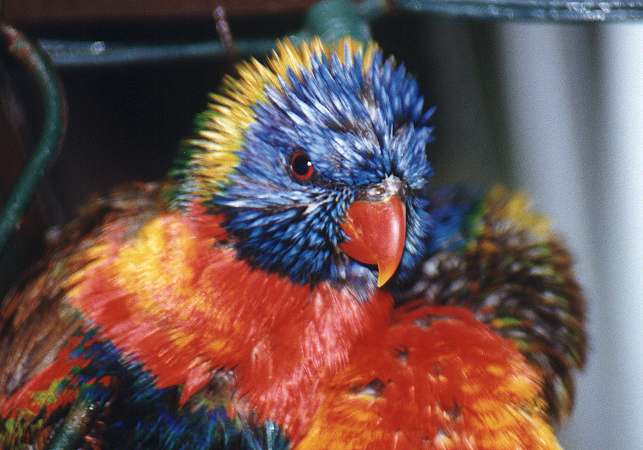 A
thunderstorm lasted the entire day, so there was no chance to go out and
bird. RAINBOW LORIKEETS stood on an empty feeder on the porch of the dining
hall to take shelter from the downpour. A pair of MASKED LAPWINGS and some
AUSTRALIAN MAGPIES fed on the flooded lawn. I was not upset, however, because
I hope that this rain signifies the end of the drought brought by El Nino
so that the forest fires around the world would stop burning.
A
thunderstorm lasted the entire day, so there was no chance to go out and
bird. RAINBOW LORIKEETS stood on an empty feeder on the porch of the dining
hall to take shelter from the downpour. A pair of MASKED LAPWINGS and some
AUSTRALIAN MAGPIES fed on the flooded lawn. I was not upset, however, because
I hope that this rain signifies the end of the drought brought by El Nino
so that the forest fires around the world would stop burning.
At night, the manager showed me a closet full of stuffed birds, mammals, and reptiles. Only then did I realize what a huge and cute bird the Tawny Frogmouth actually was. He told me that huge fruit bats, Barn Owls, and Tawny Frogmouths were common in the area. That night, I heard many fruit bats and even saw the shadow of one flying through the darkness, but I did not find any frogmouths or owls.
April 11, Saturday
The morning was too rainy to go out, so I stayed inside to catch some sleep. On the way to breakfast, I saw four LAUGHING KOOKABURRAS in the tree this time and more RAINBOW LORIKEETS at the feeder outside the dining hall.
 The
day was spent at the Royal Easter Show. It had stopped raining and the
day was mostly cloudy, with occasional breaks of sunshine. After our last
performance for the trip, we had a whole afternoon free to wander around
the show. Unfortunately, I had decided to leave my binoculars on the coach
because I thought there would not be any birds to see among the crowds.
Imagine my frustration when I took out the map and saw on it "Waterbird
Refuge" and "Mangroves" right next to the showground! Damn, how could I
be so stupid?! If I had brought my binoculars, maybe I would have reached
my goal of seeing one hundred species! I spent the entire afternoon pissed
at myself and had a miserable time at the show.
The
day was spent at the Royal Easter Show. It had stopped raining and the
day was mostly cloudy, with occasional breaks of sunshine. After our last
performance for the trip, we had a whole afternoon free to wander around
the show. Unfortunately, I had decided to leave my binoculars on the coach
because I thought there would not be any birds to see among the crowds.
Imagine my frustration when I took out the map and saw on it "Waterbird
Refuge" and "Mangroves" right next to the showground! Damn, how could I
be so stupid?! If I had brought my binoculars, maybe I would have reached
my goal of seeing one hundred species! I spent the entire afternoon pissed
at myself and had a miserable time at the show.
We went to Hard Rock cafe that night to close our tour. A clown-magician came to entertain us and gave all of us balloon animals. I felt much better after dinner and tried to forget about my frustrations that afternoon.
April 12, Sunday
 The
last day, we left Collaroy Center before dawn and got a glimpse of the
beautiful sunrise on the way. As we left the center, I saw a river nearby
with mangroves that I somehow missed earlier. Oh well, it was too late
to birding there now anyway! At our stop at Cairns, I was greeted by sparkling
blue waters, forest-covered hillsides, and lush mangroves on the shore.
Unfortunately, however, no birds were active around the airport at noon.
I wished that I could stay for a couple days in Cairns as well. By now,
I knew that Australia was a place that I would definitely return for a
longer visit sometime in the future.
The
last day, we left Collaroy Center before dawn and got a glimpse of the
beautiful sunrise on the way. As we left the center, I saw a river nearby
with mangroves that I somehow missed earlier. Oh well, it was too late
to birding there now anyway! At our stop at Cairns, I was greeted by sparkling
blue waters, forest-covered hillsides, and lush mangroves on the shore.
Unfortunately, however, no birds were active around the airport at noon.
I wished that I could stay for a couple days in Cairns as well. By now,
I knew that Australia was a place that I would definitely return for a
longer visit sometime in the future.
 On
the flight from Cairns to Taipei, I sat by the window and looked outside
frequently. As we flew over Papua New Guinea, where I have longed to visit,
I was glad to see endless tracts of pristine rainforest, unbroken except
where rivers flowed. The Philippines, however, was another story. I saw
smoke rising from every hilltop, and the fires were chewing away at the
lush green forest. For most of the time, I could not even see the land
through the clouds stained yellowish-grey by the thick smoke. Apparently,
the disastrous rainforest fires were still burning...
On
the flight from Cairns to Taipei, I sat by the window and looked outside
frequently. As we flew over Papua New Guinea, where I have longed to visit,
I was glad to see endless tracts of pristine rainforest, unbroken except
where rivers flowed. The Philippines, however, was another story. I saw
smoke rising from every hilltop, and the fires were chewing away at the
lush green forest. For most of the time, I could not even see the land
through the clouds stained yellowish-grey by the thick smoke. Apparently,
the disastrous rainforest fires were still burning...

List of species seen: